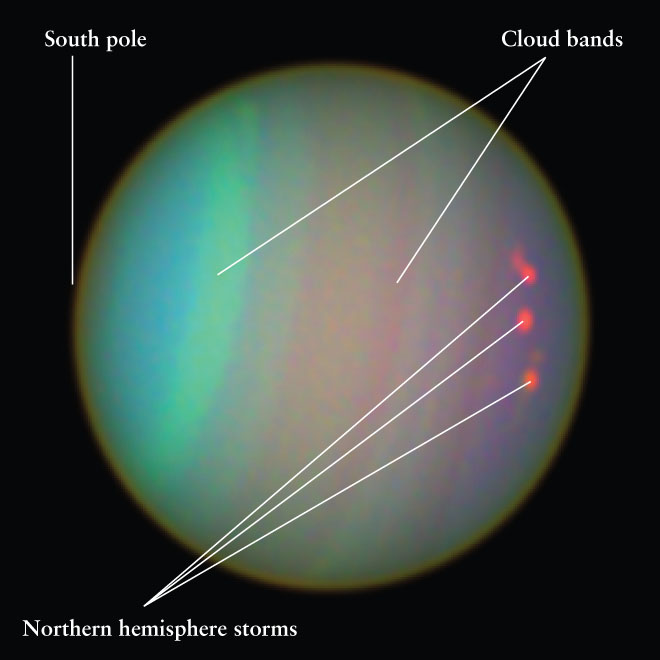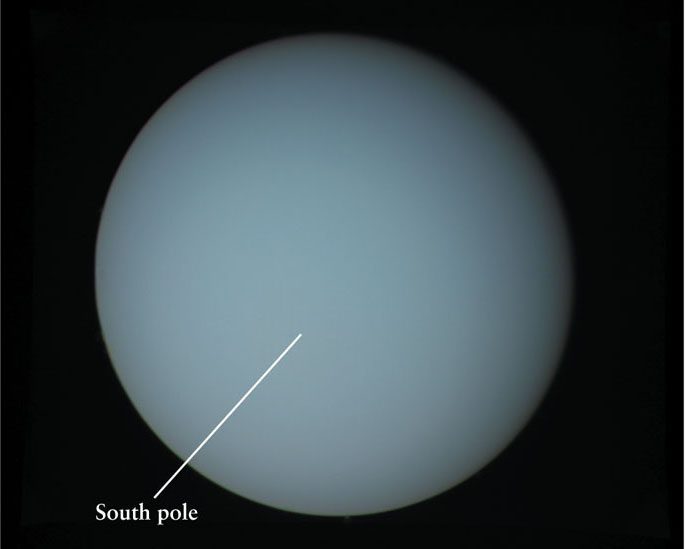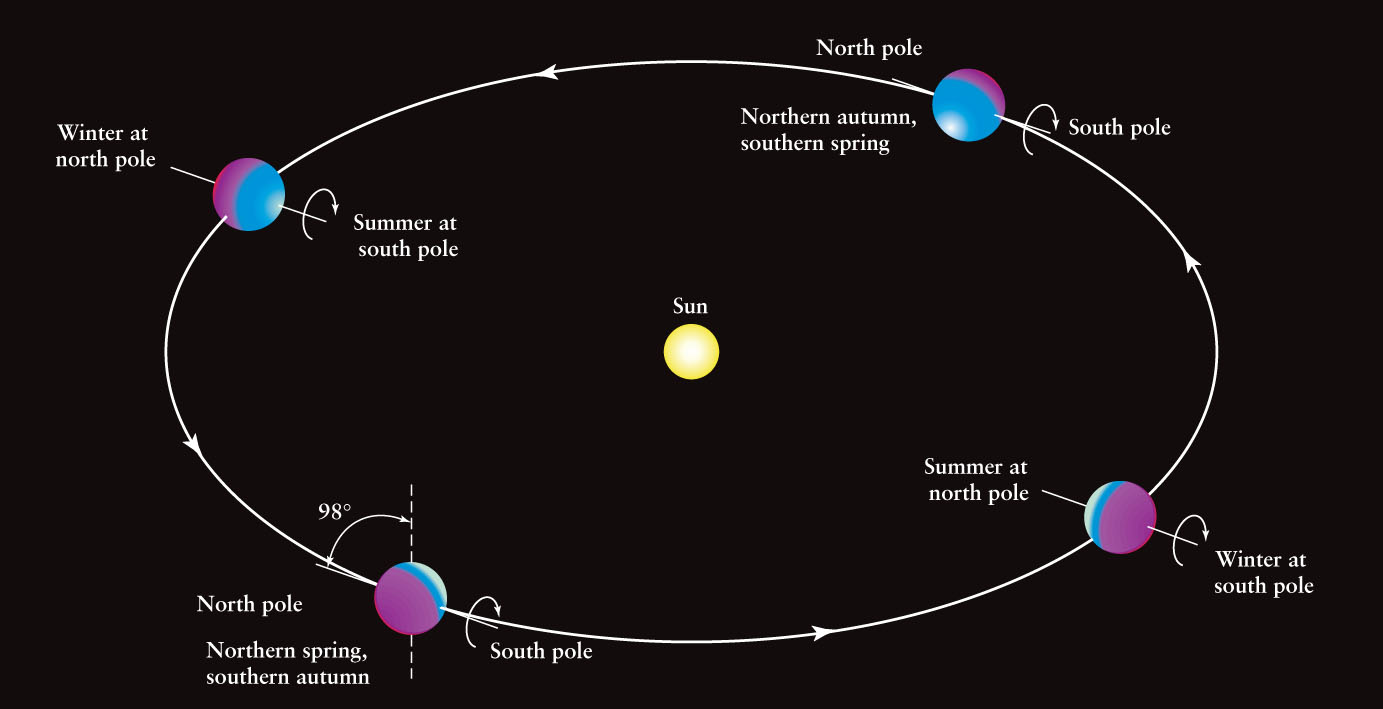14-2 Uranus is nearly featureless and has an unusually tilted axis of rotation
 Scientists had hoped that Voyager 2 would reveal cloud patterns in Uranus’s atmosphere when it flew past the planet in January 1986. But even images recorded at close range showed Uranus to be remarkably featureless (Figure 14-1). Faint cloud markings became visible in images of Uranus only after extreme computer enhancement (Figure 14-2).
Scientists had hoped that Voyager 2 would reveal cloud patterns in Uranus’s atmosphere when it flew past the planet in January 1986. But even images recorded at close range showed Uranus to be remarkably featureless (Figure 14-1). Faint cloud markings became visible in images of Uranus only after extreme computer enhancement (Figure 14-2).

Uranus from the Hubble Space Telescope Images made at infrared, visible, and ultraviolet wavelengths were combined and enhanced to give this false-color view of cloud features on Uranus. These images were captured in August 2004 (18 years after the image in Figure 14-1), during springtime in Uranus’s northern hemisphere.

Uranus from Voyager 2 This image looks nearly straight down onto Uranus’s south pole, which was pointed almost directly at the Sun when Voyager 2 flew past in 1986. None of the Voyager 2 images of Uranus shows any pronounced cloud patterns. The color is due to methane in the planet’s atmosphere, which absorbs red light but reflects green and blue.
Uranus’s Atmosphere
Voyager 2 data confirmed that the Uranian atmosphere is dominated by hydrogen (82.5%) and helium (15.2%), similar to the atmospheres of Jupiter and Saturn. Uranus differs, however, in that 2.3% of its atmosphere is methane (CH4), which is 5 to 10 times the percentage found on Jupiter and Saturn. In fact, Uranus has a higher percentage of all heavy elements—including carbon atoms, which are found in molecules of methane—than Jupiter and Saturn. (In Section 14-4 we will investigate how this could have come about.)
Methane preferentially absorbs the longer wavelengths of visible light, so sunlight reflected from Uranus’s upper atmosphere is depleted of its reds and yellows. Fewer reds and yellows in the reflected light gives the planet its distinct greenish-blue appearance. As on Saturn’s moon Titan (see Section 13-8), ultraviolet light from the Sun turns some of the methane gas into a hydrocarbon haze, making it difficult to see the lower levels of the atmosphere.
Ammonia (NH3), which constitutes 0.01 to 0.03% of the atmospheres of Jupiter and Saturn, is almost completely absent from the Uranian atmosphere. The reason for this absence is that Uranus is colder than Jupiter or Saturn: The temperature in its upper atmosphere is only 55 K (−218°C = −360°F). Ammonia freezes at these very low temperatures, so any ammonia has long since precipitated out of the atmosphere and into the planet’s interior. For the same reason, Uranus’s atmosphere is also lacking in water. Hence, the substances that make up the clouds on Jupiter and Saturn—ammonia, ammonium hydrosulfide (NH4SH), and water—are not available in Uranus’s atmosphere. This helps to explain the bland, uniform appearance of the planet shown in Figure 14-1.
The few clouds found on Uranus are made primarily of methane, which condenses into droplets only if the pressure is sufficiently high. Hence, methane clouds form only at lower levels within the atmosphere, where they are difficult to see.
An Oddly Tilted Planet
The rotation period of Uranus’s atmosphere is about 16 hours. Like Jupiter and Saturn, Uranus rotates differentially, so this period depends on the latitude and can be measured by tracking the motions of clouds. To determine the rotation period for the underlying body of the planet, scientists looked to Uranus’s magnetic field, which is presumably anchored in the planet’s interior, or at least in the deeper and denser layers of its atmosphere. Data from Voyager 2 indicate that Uranus’s internal period of rotation is 17.24 hours.
Voyager 2 also confirmed that Uranus’s rotation axis is tilted in a unique and bizarre way. Herschel found the first evidence of this in 1787, when he discovered two moons orbiting Uranus in a plane that is almost perpendicular to the plane of the planet’s orbit around the Sun. Thus, compared to the other planets, Uranus is nearly tipped on its side (Figure 14-3).

 Exaggerated Seasons on Uranus For most planets, the rotation axis is roughly perpendicular to the plane of the planet’s orbit around the Sun. But for Uranus the rotation axis is tilted by 98° from the perpendicular. This tilt causes severely exaggerated seasons. For example, during midsummer at Uranus’s south pole, the Sun appears nearly overhead for many Earth years, while the planet’s northern regions are in continuous darkness. Half an orbit later, the seasons are reversed.
Exaggerated Seasons on Uranus For most planets, the rotation axis is roughly perpendicular to the plane of the planet’s orbit around the Sun. But for Uranus the rotation axis is tilted by 98° from the perpendicular. This tilt causes severely exaggerated seasons. For example, during midsummer at Uranus’s south pole, the Sun appears nearly overhead for many Earth years, while the planet’s northern regions are in continuous darkness. Half an orbit later, the seasons are reversed.
Careful measurement shows that Uranus’s axis of rotation is tilted by 98°, as compared to 23½° for Earth (compare Figure 14-3 with Figure 2-12). A tilt angle greater than 90° means that Uranus exhibits retrograde (backward) rotation like that of Venus, shown in Figure 11-4b. Astronomers suspect that Uranus might have acquired its large tilt angle billions of years ago, when one or more massive bodies collided with Uranus while the planet was still forming. It turns out that the moons of Uranus place constraints on such axis-tilting impacts, and we will discuss this scenario further in Section 14-7.
The radical tilt of its axis means that as Uranus moves along its 84-year orbit, its north and south poles alternately point toward or away from the Sun. This tilt produces highly exaggerated seasonal changes. For example, when Voyager 2 flew by in 1986, Uranus’s south pole was pointed toward the Sun. Most of the planet’s southern hemisphere was bathed in continuous sunlight, while most of the northern hemisphere was subjected to a continuous, frigid winter night. But over the following quarter of a Uranian year later (21 of our years), sunlight has gradually been returning to the northern hemisphere, triggering immense storms there. Figure 14-2 shows some of these storms, which are much more visible at infrared wavelengths than with visible light.
Atmospheric Motions on Uranus
By following the motions of clouds and storm systems on Uranus, scientists find that the planet’s winds flow to the east—that is, in the same direction as the planet’s rotation—at northern and southern latitudes, but to the west near the equator. This wind pattern is quite unlike the situation on Jupiter and Saturn, where the zonal winds alternate direction many times between the north and south poles (see Section 12-4). The fastest Uranian winds (about 700 km/h, or 440 mi/h) are found at the equator.
Unlike the other Jovian planets, Uranus’s interior heat has no effect on its atmosphere’s motions
We saw in Section 12-4 that the internal heat of Jupiter and Saturn plays a major role in driving atmospheric activity on those worlds. Uranus is different: It appears to have little or no internal source of thermal energy. Measurements to date show that unlike Jupiter or Saturn, Uranus radiates into space only as much energy as it receives from the Sun. With only feeble sunlight to provide energy to its atmosphere, and little internal thermal energy, Uranus lacks the dramatic wind and cloud dynamics found on Jupiter and Saturn. It is not known why Uranus lacks a significant source of internal thermal energy.
Although Uranus’s equatorial region was receiving little sunlight at the time of the Voyager 2 flyby, the atmospheric temperature there (about 55 K = −218°C = −359°F) was not too different from that at the sunlit pole. Heat must therefore be efficiently transported from the poles to the equator. This north-south heat transport, which is perpendicular to the wind flow, may have mixed and homogenized the atmosphere to make Uranus nearly featureless.
CONCEPT CHECK 14-2
If methane were absent from Uranus’s atmosphere, what color would it appear?
Methane in Uranus’s atmosphere absorbs the Sun’s longer wavelengths of light, so if it were absent, Uranus would have more reds and, as a result, appear more yellow-white, like Saturn.